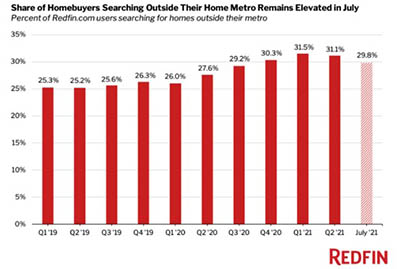
Migration of Homebuyers to Miami Triple Since Last Year

Last week saw two reports two reports that seemingly defied conventional wisdom—despite the very real effects of climate change, properties in some of the most vulnerable spots in the nation are actually attracting more interest—and higher prices. This week, another report shows Miami and other high-risk coastal areas continue to rank in the top 10 U.S. locations for net migration.
Redfin, Seattle, said three of the 10 most popular migration destinations in July were to Florida, which faces high risk from storms and rising sea levels. The report said net inflows of Redfin.com home searchers saw Miami with a net inflow of 7,610 in July, more than triple the 2,216 it saw a year earlier. Two other Florida metros—Tampa and Cape Coral—also made the top 10 last month and experienced year-over-year increases in net inflow.
The report also cited Sacramento, Phoenix and Las Vegas as the most popular migration destinations based on net inflow among major U.S. metros in July. The analysis is based on a sample of 2 million Redfin.com users who searched for homes across 112 metro areas in July, excluding searches unlikely to precede an actual relocation or home purchase.
“Miami has always been a melting pot, but the pandemic has brought even more out-of-towners to the area because so many people can now work from wherever they want,” said Miami Redfin real estate agent Milagros Alvarez. “Homebuyers are moving here from all over the map—Atlanta, Cincinnati, New York, Columbia, Mexico City, Pittsburgh and Philly, to name a few. The beaches, warm weather and low taxes are the major draws. Florida has also been much less shut down than other states during the pandemic, which some house hunters see as a positive.”
The report noted while Miami’s climate is a selling point for many homebuyers, it also poses risks. The city is one of the most vulnerable in the world when it comes to damages caused by coastal flooding and storms. More than half (59%) of Miami’s properties face some level of flood risk, according to First Street Foundation’s Flood Factor. Sea levels in Miami-Dade County are projected to rise two feet or more by 2060, threatening to displace many residents. The region also faces extreme heat risk.
Still, most clients Alvarez works with don’t see these factors as dealbreakers. “The homebuyers I talk to rarely mention climate change. Most of them aren’t concerned,” she said. “A lot of people seem to have this idea that it won’t impact them in their lifetime, so it doesn’t need to be a consideration when buying a home.”
“Many people who move to Miami are thinking about the short-term benefits of living in such a vibrant, beautiful and prosperous city,” said Redfin Chief Economist Daryl Fairweather. “We know from the recent U.N. climate report that places like Miami will see the impacts of climate change within the next thirty years. Miami homebuyers should think about how they can make their homes more resilient to climate change and how their finances would be impacted if their homes lost value.”
The report said San Francisco, Los Angeles, New York, Washington, D.C. and Boston saw more Redfin.com users move away than any other metro areas in July, meaning they had the biggest net outflows. Fairweather said while big, expensive cities normally lose the most residents, that trend accelerated during the pandemic as remote work gave people the flexibility to leave expensive job centers for relatively affordable places.
Nationwide, 29.8% of Redfin.com users looked to move to a different metro in July, down slightly from 31.1% in the second quarter but up from 27.8% during the same month last year. As housing demand has increasingly outpaced supply, some of the most popular migration destinations have become prohibitively expensive for homebuyers.
Last week, Redfin, reported U.S. counties with the largest share of homes facing climate change risks—high heat, drought, fire, flood, storms—saw their populations grow between 2016 and 2020. In a separate report, ATTOM, Irvine, Calif., said despite dire warnings about oceanfront real estate—including the recent tragedy in Florida in which an eight-story condo building collapsed—condo prices rose by at least 20 percent in a majority of oceanfront counties around the U.S.
The Redfin analysis of data from climate-data startup ClimateCheck, county property records and the U.S. Census Bureau found the 50 U.S. counties with the largest share of homes facing high heat risk saw their populations increase by an average of 4.7% from 2016 through 2020 due to positive net migration. Meanwhile, the 50 counties with the largest percentage of homes facing high drought, fire, flood and storm risk experienced average population growth of 3.5%, 3%, 1.9% and 0.4%, respectively, due to positive net migration.
